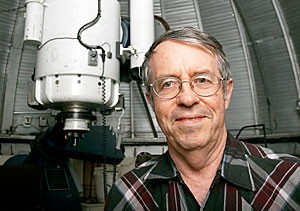The Earth’s moon is very rare in the universe, according to a recent study done by a UA professor and an alumnus.
“”The leading theory for the creation of the moon is that it was made in a collision,”” said Dr. Nadya Gorlova, the lead author of the study appearing in the Astrophysical Journal. Gorlova is currently at the University of Florida, but was a UA graduate student when the study was conducted.
At some point, around 30 million years after the sun had ignited and the planets had been mostly formed, “”there was a big collision of another planet on the scale of Mars with Earth,”” said George Rieke, a UA astronomy professor and co-author of
the study.
The matter, which would have mostly come from the mantle of the Earth, would then have come together in orbit around the Earth, forming the moon.
The density of the moon is very low, and if it has an iron core it is very small, Rieke said, making it much more likely that it was formed from the Earth, rather than aggregating on its own during the early existance of the solar system.
An impact of this magnitude would have created a lot of dust, which then would be warmed by the sun.
If this warmed dust appeared around other stars, it would have indicated that a similar moon-forming event had happened.
The research group used NASA’s infrared Spitzer Space Telescope to search for the dust, Gorlova said. They looked at 400 stars of the appropriate age, but only one had the dust indicating the type of collision they were looking for, Rieke said.
Based on the range of ages within which such an event can occur, the group estimated that there is only a 5 to 10 percent probability that a collision within a star system would form a moon like Earth’s.
The data were collected in around 10 hours of observation, Rieke said, but it took a year of analysis to determine what the data actually meant.
The numbers could be even smaller, as “”not every big collision results in a moon,”” Rieke said.
Because the other stars analyzed did not have the dust around them, it is apparent that those systems had finished forming planets – indicating the other system, and by extension Earth’s own, is indeed an anomaly, Gorlova said.
Other moons in the solar system were formed at the same time as the planet they orbit by accretion, the smashing together of smaller bodies of matter, or were wandering asteroids captured by the gravity of the planet.
These moons tend also to have a much slower rotation than Earth’s, Gorlova said.
There has been a recent rash of discovery of new planets, but Rieke said they are all in older systems around stars much closer to Earth than the ones observed for the study. He said the period of formation they were looking at was older than they had expected.
To look at systems in the proper stage of development, older light from much more distant stars had to be observed, he said.









